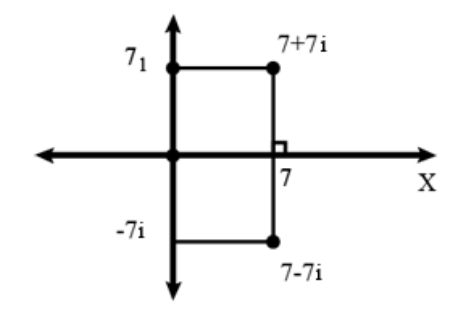
Answer
473.1k+ views
Hint: Here, we will first draw the diagram and then by symmetry of the points with respect to the \[x\]-axis, we can say \[x\]–axis is the perpendicular bisector of the line segment joining \[7 + 7i\] and \[7 - 7i\] to find the required equation.
Complete step-by-step answer:
We are given that the perpendicular bisector of the line segment joining the points \[7 + 7i\] and \[7 - 7i\] in the Argand diagram has the equation.

We know that the real part of the complex number has the \[x\]–value and the imaginary part of the complex number has the \[y\]–value.
Since we know that by symmetry of the points with respect to the \[x\]-axis, we can say \[x\]–axis is the perpendicular bisector of the line segment joining \[7 + 7i\] and \[7 - 7i\].
Thus, the required equation is \[y = 0\].
Hence, option A is correct.
Note: In solving these types of questions, students must know about the real and imaginary parts of a complex number. One should know the symmetry of the points with the axis to find the equation, which is the perpendicular bisector of the line segment.
Complete step-by-step answer:
We are given that the perpendicular bisector of the line segment joining the points \[7 + 7i\] and \[7 - 7i\] in the Argand diagram has the equation.

We know that the real part of the complex number has the \[x\]–value and the imaginary part of the complex number has the \[y\]–value.
Since we know that by symmetry of the points with respect to the \[x\]-axis, we can say \[x\]–axis is the perpendicular bisector of the line segment joining \[7 + 7i\] and \[7 - 7i\].
Thus, the required equation is \[y = 0\].
Hence, option A is correct.
Note: In solving these types of questions, students must know about the real and imaginary parts of a complex number. One should know the symmetry of the points with the axis to find the equation, which is the perpendicular bisector of the line segment.



